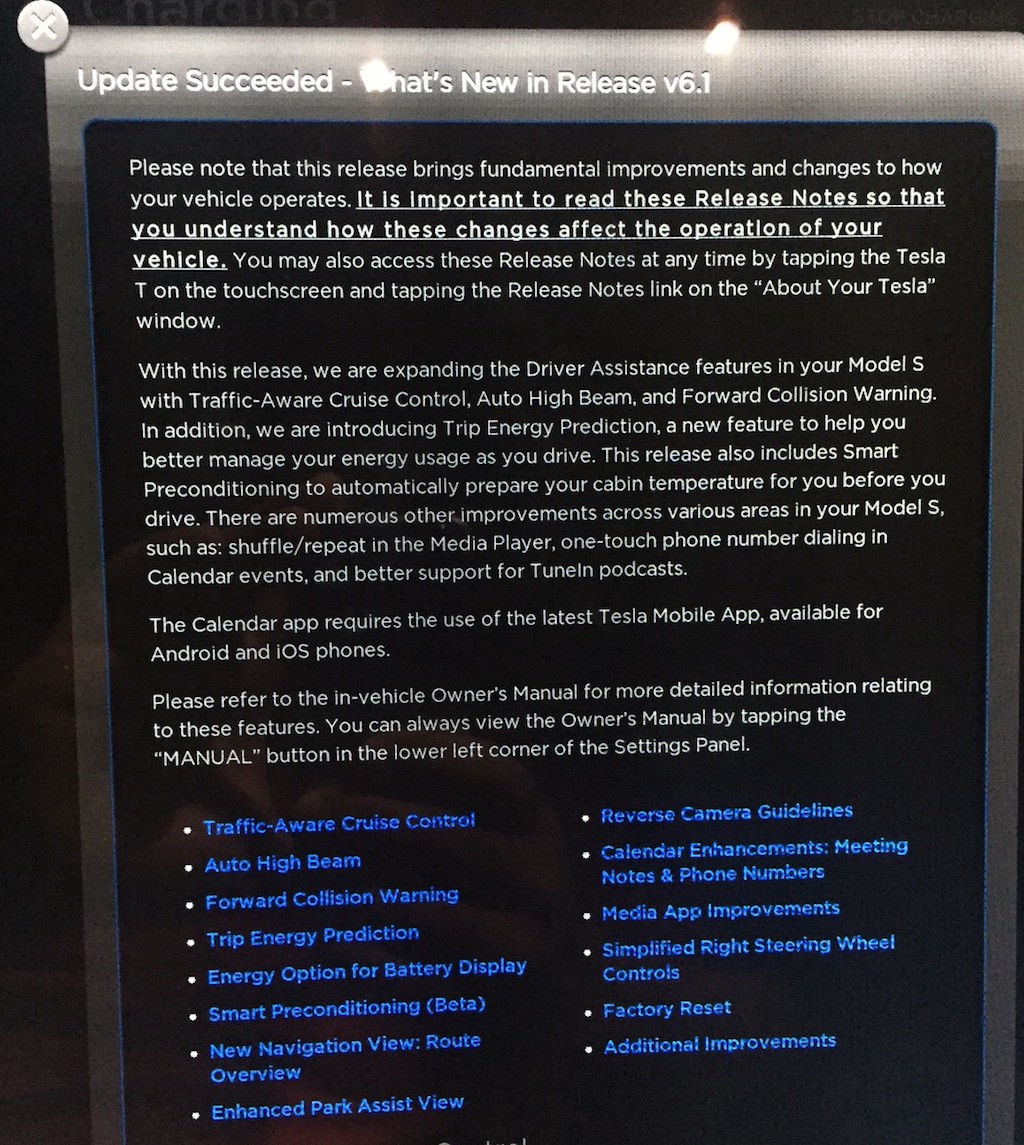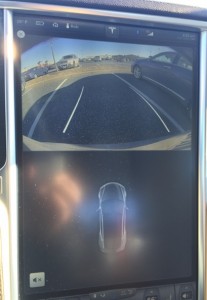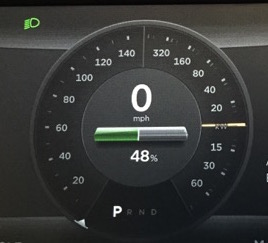News
Tesla Firmware 6.1: Range, Routes and Parking Aid

Following the review of Firmware 6.1’s Trip Energy Prediction roll out I’ll be taking a deeper look at some of the other major features that came bundled with this version such as navigation routing and the reverse camera parking aid.
Range Display: Battery %
The Model S displays battery range based on a rated or ideal measurement as determined by the methodology in which the US EPA measures electric vehicle range.
This range always seems to be a hot topic of discussion amongst owners since, almost always, the actual mileage achieved is lower than what’s displayed on the car’s dash. This is especially true during the cold New England winter months when 265 miles of rated range turns out to be closer to 160 miles of actual range due to the effects of winter driving.
The grim reality is that range based on distance (mi/km) will vary depending on how you drive, the terrain you drive on and the environmental conditions during that time.
Tesla Firmware 6.1 solves this issue by giving drivers the ability to replace the display of range with the percentage of battery life remaining. Sure there’s the color-coded battery indicator but being able to see an actual value makes it much more relatable. On top of that the amount of battery remaining lines up nicely to the energy graph displayed through the Trip Energy Prediction feature.
Using this new way of measuring your range takes some getting used to but after a week of using it I kind of like it. It certainly beats using a rated range display that ends up being off by 40-50% during the winter months.
Route Overview
 Tesla Firmware 6.1 also adds a new view for trip routing. A “Route Overview” option allows you to visualize your route using a north up view but with the ability to automatically zoom in as you approach your destination. There’s no need to manually pinch zoom anymore..
Tesla Firmware 6.1 also adds a new view for trip routing. A “Route Overview” option allows you to visualize your route using a north up view but with the ability to automatically zoom in as you approach your destination. There’s no need to manually pinch zoom anymore..
Enhanced Park Assist and Camera Guidelines
 I’m lumping these two features together but also keeping in mind that Park Assist is limited to those with the parking assist package.
I’m lumping these two features together but also keeping in mind that Park Assist is limited to those with the parking assist package.
With this new update putting the Model S in reverse will display both front and rear parking sensors making parallel parking and backing into tight spots that much easier. You also have the ability to manually trigger Park Assist as long as the car is traveling below 5mph. This is a great addition since it provides visibility for all four corners of the Model S.
Tesla finally put the rumors of having an inadequate graphics engine, that supposedly prevented the ability to render parking lines, to rest with the addition of the reverse camera guidelines.
I never had rear camera guidelines on any of my previous cars so this feature wasn’t on my wish list and I never really understood why so many people wanted them. Now that I have them I can see how it would be hard to ever go back to a car without them.
Rear camera guidelines was the #1 requested feature for years and Tesla has delivered!
Summarizing the feature, the Model S will overlay lines on the screen to indicate the path of travel when backing up. These lines move with your steering wheel and apparently the lines will change colors to ensure maximum contrast and visibility depending on the background. Here’s a video of it in action.
Summary
Tesla outdid itself with this the release of Firmware 6.1. It introduces a solid list of big features and improvements around range, routing displays and parking assistance. Combine this with the new feature to dynamically calculate range based on terrain and driving behavior, this is one of the best updates to date.
Stay tuned as I review some of the other enhancements that came bundled with this version.

Elon Musk
Elon Musk’s X will start using a Tesla-like software update strategy
The initiative seems designed to accelerate updates to the social media platform, while maintaining maximum transparency.

Elon Musk’s social media platform X will adopt a Tesla-esque approach to software updates for its algorithm.
The initiative seems designed to accelerate updates to the social media platform, while maintaining maximum transparency.
X’s updates to its updates
As per Musk in a post on X, the social media company will be making a new algorithm to determine what organic and advertising posts are recommended to users. These updates would then be repeated every four weeks.
“We will make the new 𝕏 algorithm, including all code used to determine what organic and advertising posts are recommended to users, open source in 7 days. This will be repeated every 4 weeks, with comprehensive developer notes, to help you understand what changed,” Musk wrote in his post.
The initiative somewhat mirrors Tesla’s over-the-air update model, where vehicle software is regularly refined and pushed to users with detailed release notes. This should allow users to better understand the details of X’s every update and foster a healthy feedback loop for the social media platform.
xAI and X
X, formerly Twitter, has been acquired by Elon Musk’s artificial intelligence startup, xAI last year. Since then, xAI has seen a rapid rise in valuation. Following the company’s the company’s upsized $20 billion Series E funding round, estimates now suggest that xAI is worth tens about $230 to $235 billion. That’s several times larger than Tesla when Elon Musk received his controversial 2018 CEO Performance Award.
As per xAI, the Series E funding round attracted a diverse group of investors, including Valor Equity Partners, Stepstone Group, Fidelity Management & Research Company, Qatar Investment Authority, MGX, and Baron Capital Group, among others. Strategic partners NVIDIA and Cisco Investments also continued support for building the world’s largest GPU clusters.
News
Tesla FSD Supervised wins MotorTrend’s Best Driver Assistance Award
The decision marks a notable reversal for the publication from prior years, with judges citing major real-world improvements that pushed Tesla’s latest FSD software ahead of every competing ADAS system.

Tesla’s Full Self-Driving (Supervised) system has been named the best driver-assistance technology on the market, earning top honors at the 2026 MotorTrend Best Tech Awards.
The decision marks a notable reversal for the publication from prior years, with judges citing major real-world improvements that pushed Tesla’s latest FSD software ahead of every competing ADAS system. And it wasn’t even close.
MotorTrend reverses course
MotorTrend awarded Tesla FSD (Supervised) its 2026 Best Tech Driver Assistance title after extensive testing of the latest v14 software. The publication acknowledged that it had previously criticized earlier versions of FSD for erratic behavior and near-miss incidents, ultimately favoring rivals such as GM’s Super Cruise in earlier evaluations.
According to MotorTrend, the newest iteration of FSD resolved many of those shortcomings. Testers said v14 showed far smoother behavior in complex urban scenarios, including unprotected left turns, traffic circles, emergency vehicles, and dense city streets. While the system still requires constant driver supervision, judges concluded that no other advanced driver-assistance system currently matches its breadth of capability.
Unlike rival systems that rely on combinations of cameras, radar, lidar, and mapped highways, Tesla’s FSD operates using a camera-only approach and is capable of driving on city streets, rural roads, and freeways. MotorTrend stated that pure utility, the ability to handle nearly all road types, ultimately separated FSD from competitors like Ford BlueCruise, GM Super Cruise, and BMW’s Highway Assistant.
High cost and high capability
MotorTrend also addressed FSD’s pricing, which remains significantly higher than rival systems. Tesla currently charges $8,000 for a one-time purchase or $99 per month for a subscription, compared with far lower upfront and subscription costs from other automakers. The publication noted that the premium is justified given FSD’s unmatched scope and continuous software evolution.
Safety remained a central focus of the evaluation. While testers reported collision-free operation over thousands of miles, they noted ongoing concerns around FSD’s configurable driving modes, including options that allow aggressive driving and speeds beyond posted limits. MotorTrend emphasized that, like all Level 2 systems, FSD still depends on a fully attentive human driver at all times.
Despite those caveats, the publication concluded that Tesla’s rapid software progress fundamentally reshaped the competitive landscape. For drivers seeking the most capable hands-on driver-assistance system available today, MotorTrend concluded Tesla FSD (Supervised) now stands alone at the top.
News
Elon Musk’s Grokipedia surges to 5.6M articles, almost 79% of English Wikipedia
The explosive growth marks a major milestone for the AI-powered online encyclopedia, which was launched by Elon Musk’s xAI just months ago.

Elon Musk’s Grokipedia has grown to an impressive 5,615,201 articles as of today, closing in on 79% of the English Wikipedia’s current total of 7,119,376 articles.
The explosive growth marks a major milestone for the AI-powered online encyclopedia, which was launched by Elon Musk’s xAI just months ago. Needless to say, it would only be a matter of time before Grokipedia exceeds English Wikipedia in sheer volume.
Grokipedia’s rapid growth
xAI’s vision for Grokipedia emphasizes neutrality, while Grok’s reasoning capabilities allow for fast drafting and fact-checking. When Elon Musk announced the initiative in late September 2025, he noted that Grokipedia would be an improvement to Wikipedia because it would be designed to avoid bias.
At the time, Musk noted that Grokipedia “is a necessary step towards the xAI goal of understanding the Universe.”
Grokipedia was launched in late October, and while xAI was careful to list it only as Version 0.1 at the time, the online encyclopedia immediately earned praise. Wikipedia co-founder Larry Sanger highlighted the project’s innovative approach, noting how it leverages AI to fill knowledge gaps and enable rapid updates. Netizens also observed how Grokipedia tends to present articles in a more objective manner compared to Wikipedia, which is edited by humans.
Elon Musk’s ambitious plans
With 5,615,201 total articles, Grokipedia has now grown to almost 79% of English Wikipedia’s article base. This is incredibly quick, though Grokipedia remains text-only for now. xAI, for its part, has now updated the online encyclopedia’s iteration to v0.2.
Elon Musk has shared bold ideas for Grokipedia, including sending a record of the entire knowledge base to space as part of xAI’s mission to preserve and expand human understanding. At some point, Musk stated that Grokipedia will be renamed to Encyclopedia Galactica, and it will be sent to the cosmos.
“When Grokipedia is good enough (long way to go), we will change the name to Encyclopedia Galactica. It will be an open source distillation of all knowledge, including audio, images and video. Join xAI to help build the sci-fi version of the Library of Alexandria!” Musk wrote, adding in a later post that “Copies will be etched in stone and sent to the Moon, Mars and beyond. This time, it will not be lost.”









